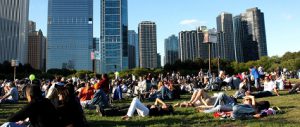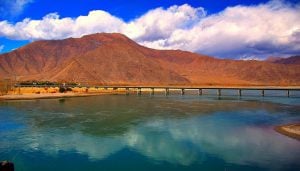An incongruous new sight has risen up in the countryside of eastern China: a skyscraper taller than any building in London or Tokyo, topped by what looks very much like a giant, golden disco ball. The 328-metre super-tower, which juts out of the Jiangsu plains like a trophy on an empty shelf, was opened in October by the village of Huaxi, a communist model community with a registered population of just 2,000 “farmers”.
Having been built up to the heavens during a period of global economic collapse, the mega-tower will be heralded as the latest symbol of China’s extraordinary economic expansion. But this bizarre new addition to the province’s landscape also speaks volumes about the land pressures, environmental stress, inequality and rash investment that threaten the country’s long-term growth.
The skyscraper will primarily be used as a gourmet dining hall and luxury hotel. Though many of those who live in its shadow earn less than US$16 a day, there is no attempt to hide the wealth gap. From a gold-leaf-covered reception area to a 60th floor inlaid with genuine flakes of gold, the building exudes wealth and excess. Its proudest feature is a one-tonne, solid gold statue of an ox, said to be worth 300 million yuan (about US$47 million).
The mega-statistics do not stop there. With 826 bedrooms and dining facilities for 5,000 guests – including southern China’s biggest banquet hall – there is almost enough space to accommodate and feed all of the original village residents at a single sitting.
It is the brainchild of Wu Renbao, the driving force behind Huaxi’s 40-year transition from a small village to a multibillion-dollar conglomerate with interests in steel, shipping, tobacco and textiles. By turns a communist dictator, capitalist entrepreneur and self-help guru, the 84-year-old is among China’s most colourful characters. He is praised for turning Huaxi into one of the richest villages in China and enriching the original residents with annual shares, dividends and free overseas trips. He is also criticised for turning the community into a family fiefdom, in which workers get no holidays and his relatives get the best posts.
He has created a hierarchy largely determined by closeness to the Wu clan. Those from the original 2,000 Huaxi families are at the top of the pyramid. Next come the 35,000 residents from neighbouring villages that have been swallowed up by Huaxi’s expansion. At the bottom are 20,000 newly arrived migrants, who provide labour for the factories on 12-hour shifts without weekend breaks. The monthly salaries of 3,000 yuan (US$470) are better than average for low-skilled labour in China, but it is hardly a worker’s paradise.
Wu is undoubtedly Huaxi’s greatest draw. Coachloads of visitors – mostly cadres and retirees – turn up to listen to the 10.30am lecture he delivers every day in a village auditorium that has been decked out to resemble the Great Hall of the People in Beijing. His close connections to the central government ensure supportive policies – for example, planning permission to build a 72-storey skyscraper in an area where the next-biggest building in less than 20 floors tall. Wu says he looked to the mega-cities of the Middle East for inspiration.
“This tower is my idea,” the patriarch says in such a thick local accent that the interpreter needs an interpreter. “We learned from Dubai, but taking into account our domestic situation, we decided the height should be 328 metres. Why 328 metres? Because that is as tall as the highest building in Beijing.” Chinese culture loads numbers with significance: 32 is associated with business and eight represents prosperity.
As village officials also proudly noted in the invitation to the opening ceremony: “There are 209 countries that lack such a tall building.” That includes the United Kingdom. The Shard London Bridge – which will be the tallest building in the European Union when it is completed next year – is 18 metres shorter than Huaxi’s new village centre.
Even for those used to the speed and scale of change in China, this is astonishing. The last time I visited Huaxi in 2005, it was building a cluster of giant pagodas, which then appeared outlandishly large compared to everything else in the village. Today, those same pagodas barely register in comparison to the super-tower beside them, which pulsates in all the colours of the rainbow when night falls.
It is a tacky but impressive reminder of how far the village has come since the Mao era. That message is reinforced at the village museum, where old propaganda footage shows farmers breaking rocks, labouring in the fields and living in small, unfurnished homes. It is also evident in the small park, which preserves Wu’s first factory, a whitewashed, single-storey building.
“We used to have a very difficult life. We lived in a thatched shed, ate bran and had nothing in our pockets,” recalls Wu, whose message can be distilled to a drive for GDP growth. “I think it will never be wrong to expand the economy and make ordinary people rich. In our opinion, that is the priority.”
This approach has worked for decades and never more so than during the past seven years, when Huaxi’s sales have increased fivefold. But the skyscraper is a towering indicator that business-as-usual is no longer working. The 3.5 billion yuan (US$550 million) investment is designed to attract tourists and new business to Huaxi as it attempts the leap from dirty industrial centre to an ecologically friendly service-sector economy.
In making the transition from third-world village to first-world skyscraper, Huaxi is in many ways a microcosm of China. But the next step will be harder as it tries to cope with the declining competitiveness of its core industry, the inflated cost of land and worries about the environment. In this case, an even wider comparison can be drawn: like the global economy, Huaxi may be bumping up against limits to growth.
Until recently, the village earned half of its income from the iron and steel industry. But today, this has fallen to less than a third. This collapse is due to rising material costs, the expansion of rival firms and falling demand both overseas and in China.
“This is the worst situation I have experienced,” says Yang Yongchang, who has been general manager of the Jiangyin Huaxi Iron and Steel Company for eight years. “It will get worse in the future. People in this industry are panicking.” He says Huaxi is planning to move the factory so it can reinvent itself as a tourist resort and commodities-trading hub. “We’re trying to build an ecological village that looks like a forest garden,” he says.
The costs of fast, dirty, old-style economic growth can no longer be ignored. Wu Yunfang, the head of environmental affairs in the local communist party, says the village has recently shut down five chemical and textile factories that once used to discharge pollutants into the local Zhangjiagang River. She estimates the value of the lost production at 150 million yuan (US$23.5 million), which adds up to a significant environment bill along with the 350 million yuan (US$55 million) spent on emissions scrubbing and wastewater treatment.
Territorial expansion is also becoming more expensive. In the past two decades, Huaxi swallowed 12 neighbouring villages as its industry and influence sprawled outwards. It is not officially a merger. The official terminology is that the villages are “united under Huaxi”, but the reality is far more like a corporate takeover. Huaxi paid an annual fee to the surrounding villages and in return it gained control of economic management, land use decisions, labour issues and political appointments.
The loss of independence is worthwhile, according to Zhang Zhongxian, the former head of Xixiang village, who is now working for Huaxi’s labour federation. Since his community was subsumed by Huaxi in 2002, Zhang estimates that average annual incomes have more than tripled, welfare for the elderly and disabled has improved and homes and roads have been upgraded. “In five to 10 years, we will be where Huaxi is now,” Zhang says. “Many other villagers want to join. Even some from other provinces.”
But land costs have risen dramatically. Huaxi’s village chief, Wu Xie’en – the son of Wu Renbao – said this was a major factor in the decision to build the tower, which has been dubbed “a village in the air”. He says: “With the completion of this building, we can save a vast expanse of land. In China, the trend now is to build tall because the more the economy develops, the more space is needed. Where is the space for China in the future? We must look to the sky.” The party secretary says he wants to turn the “city village” of Huaxi into a Shangri-La. “My father made people rich. Now I want to make them healthy and happy.”
The tower seems an odd way to do this. But the Wus argue that they have succeeded over the years by anticipating changes in the economic wind and gambling big on the outcome. They are trying again this time. Just in case the outside world fails to notice, Huaxi invited the international media to the village’s 50th anniversary celebration, when the skyscraper was officially unveiled. To give visitors a better view, villagers have started a helicopter business – a first step in a planned expansion into commercial aviation and high-end tourism.
If anywhere in China can find new areas of economic expansion, it is Huaxi. But even with the political connections and business nous, it is hard to imagine that the village will reinvent itself as a tourist centre – particularly given the advanced age of the retired party secretary who is its main attraction.
But Huaxi has proved its doubters wrong in the past. Ahead of the opening of the new skyscraper, the mood on the streets was optimistic. In the evening, locals, neighbours and migrants gathered to dance on the village square, a huge expanse of concrete between 15-storey pagodas that pulsate pink, blue, green and yellow. One migrant labourer from the steel factory, who declined to give his name, said the tower would help the economy and create new opportunities.
“Nobody would invest so much money in something that wasn’t sure to be a success, right?”
Additional reporting by Cecily Huang.
https://www.guardian.co.uk/
Copyright © Guardian News and Media Limited 2011
Homepage image by Chitingshanren




